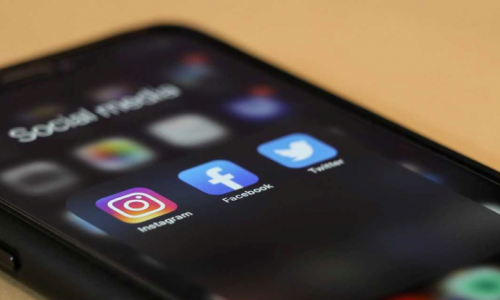
Compared to the past, social media apps now have a bigger hold on us, more than ever. They can influence how we feel and what we do, for better or for worse. Social media started off as a platform for people to connect with each other, and while they still do that, a much more common element of social media apps is their ability to promote products and services. Brands rely highly on social media influencers to promote their products and in return, consumers also turn to social media to research products. Consumers have an almost parasocial relationship with influencers, where they connect and relate to an influencer without even knowing them personally. Influencers are very effective at promoting products because of this, which is why it is becoming more common for brands to work alongside influencers.
The desire to keep up with trends means we are consuming more than we need. Our interest is easily piqued by content such as try-on hauls (where clothes are tried on and shown on camera), unboxing of products, suggesting dupes (a similar product that is less expensive) or reviews of the latest makeup, clothing, technology, or homeware releases. It's safe to assume that we are spending more than we should. However, a new trend has been seen on TikTok (+ across social media apps)and that is the de-influencing trend. De-influencing is essentially the opposite of influencing, it is convincing people to not buy things. Perhaps this is a response to the commercialization of the app, or a way to encourage conscientious spending. To understand why TikTok has such a strong hold on marketing, we need to understand why the app is so good at influencing people:
Social media, content creation and influencing has become a more common way to earn income. An influencer is “somebody who has the ability to influence potential sales of a product by promoting them on social media.” They usually do so alongside their other content, which can range from travel vlogs, fashion influencers, work out tutorials and even streaming video games. One of the reasons they can profit from this kind of job is by doing sponsorships. This is when companies pay you to promote a product or their brand. Influencers will be obliged to review the product positively, and it can be hard to tell if they are being genuine. As a result, we go on to have impressions that all these products are good, and we are more likely to purchase them in the future. This can happen on any social media applications but it is especially prominent on TikTok. The nature of the app allows for short but engaging videos, which is why people become easily addicted to it. It even has its own hashtag, #tiktokmademebuyit to denote its overwhelming ability to promote new products.
What is an it girl? An “it” girl is simply that girl. The “it” girl is basically seen as somebody who has their life together, has the perfect lifestyle and somebody who is always makes everything they do seem effortless. The term It girl is most commonly thrown around but there are also male equivalents out there. These could be men who are popular, stylish and admired by other people. When it comes to being an "it" girl or and "it" boy, it is mainly about the confidence they exude in everyday life, which is why these are people we commonly aspire to be like. They are not only role models to other people, but they also live a lifestyle that many people aim to achieve. TikTok once again poses the perfect stage for these people to show off their lifestyle. I think it is perfectly fine to showcase your everyday life to others, as it can even make others feel motivated to achieve this lifestyle in healthy ways. But it can also cause the wrong type of motivation. People may feel compelled to buy the same products these influencers use in hopes of achieving the same lifestyle when much more than material products go into achieving these lifestyles such as mindsets, habits and sometimes even hard work. Another reason people may resonate with online influencers more than an A list celebrity is because they feel more in touch with them. When influencers show off their everyday life, most of the time it does seem that far off from ours, which is why we resonate more with what they say and do online. However, at the end of the day, social media apps are almost like a mask, you never know what truly goes on in somebody’s life, all you know is the façade they want you to see.
The act of spending has become a psychological survival tool in modern times. And this phenomenon happens at different levels. The phrase “treat yourself” is a lighthearted term that basically means to do something nice for yourself. An example is buying yourself a cup of coffee to reward yourself for a day of hard work. This is not a necessity, but just something you do for the sake of pleasure. In Korea, there is a similar mindset but at a more intense level: consumption used for the sake of stress relief. Spending money on small inconsequential things when life gets hard is seen as a way to feel in control of your life. This is like the treat yourself mentality but with a more serious tone, it almost conveys a sense of hopelessness. With everything becoming so expensive and more things become unaffordable and out of reach, it almost like saying “life is already hard, I will never be able to afford that house, why not spend my money on something small for an instant boost in happiness for now?” The bottom line is shopping has become a form of self-therapy in the modern world, and this only contributes to our extra spending habits. Of course, the sensible thing would be to save your money on only important things. But who wants to live a life without the instant gratification of material products every now and then?
Our spending habits have led us to a world where overconsumption is tolerated. Influencers getting sent tons of free products to promote, people filming hauls of products they don’t need, the urge to spend because of the increasing stress people face in everyday life.
Encouraging people to spend wisely is not a new phenomenon. There have always been content creators that have warned us about the dangers of overconsumption and have advocated for more sustainable ways to shop. But de-influencing has specifically been picked up by TikTok creators and has garnered a lot of attention. Maddie Wells, a beauty influencer, had a video series about the most returned products at beauty stores she worked at and would always remind her followers to not fall for the initial hype of products seen on TikTok. Since then, other creators have followed suit to the point where this movement became a trend that started on TikTok but moved to various other social media platforms.
Most videos will come in the form of reviewing over hyped products, ones that commonly have the #tiktokmademebuyit hashtags in the descriptions. “De-Influencers” will give you a brutally honest review telling you that some of these products are not worth the money at all and will offer alternatives that are cheaper and better quality, while other videos remind you to not spend your money on certain products at all. As redundant as it sounds, TikTok is very good at promoting products, to the point that stores in real life will label viral products with “As seen on TikTok.” It can be easy to fall into the trap of buying things you don’t need, even I am a victim of being easily influenced from time to time. Something as simple as seeing a 1-minute video telling you to think twice about buying something can be the reminder you need to not make that impulse purchase.
The bigger picture this trend is trying to encourage is to raise awareness about how social media is promoting overconsumption. These content creators are very effective at what they do for a few reasons. They are likely to have followers who already resonate with them and connect with their content on some level. They’re more likely to believe what they’re saying because in their eyes, they’re a trustworthy individual. Negative information is also more believable, because in an overwhelming sea of overhyped products and influencers constantly pushing brands, a negative review will stick out and seem like a more honest review.
This is also causing a shift in the way influencers operate. In the past, before we had an overload of influencers on the internet, accepting brand deals and promoting products was a novel concept. Having many brand deals was a way of saying you were a sought-after individual that people wanted to work with. There was also a lack of transparency on how influencers made income this way, because of how new the concept was. However, nowadays, this approach will not be met with the same response. Audiences are now starting to see through the inauthenticity that comes with these brand deals. They’re less tolerant of those who constantly push products onto others because they don’t want to be seen as gullible and easily manipulated into buying anything and everything. If influencers don't disclose that they're being sponsored by a brand, it comes of as ingenuine and untrustworthy, and will hurt your relationship with your audience. Advertising products is now only effective when you have built a reputation as an honest content creator. Because creators will now face backlash for mindlessly promoting too many products, they're more inclined to take up the de-influencing trend to appear as authentic as they can to their audience. Jumping on the de-influencing bandwagon is one of the strategies they use in order to stay relevant and influence you to buy these products. Only when your audience trusts you is when they will start to care about the products and brands you advocate for.
The de-influencing trend is fascinating to me because the dangers of overconsumption are finally coming to the surface again. Overconsumption has always been a problem, but on social media, where making money becomes the priority for influencers, it almost felt like there was an elephant in the room. It felt as if people were always hopping from one trend to another, and when something went out of style, they would immediately go on to buy the next big thing. Warnings about overconsumption and reckless spending are not new, however the fact that the whole phenomenon of de-influencing has become a trend serves as a good reminder to think twice before you shop. This movement can be thought of as the antithesis to keeping up with every single trend, and it is good to see people with a platform to remind their audience that material objects aren’t everything in life. Trends will come and go, but I think de-influencing is a trend that needs to stay.



















